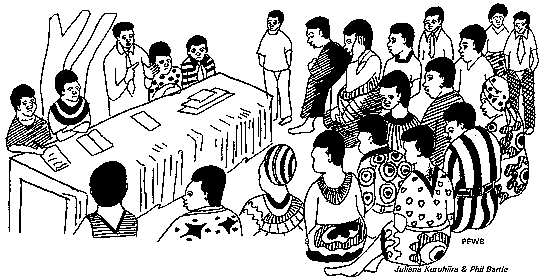Tweet
Translations:
'العربية / al-ʿarabīyah
Bahasa Indonesia
বাংলা / Baṅla
Català
中文 / Zhōngwén
English
Español
Filipino/Tagalog
Français
Ελληνικά / Elliniká
हिन्दी / hindī
Italiano
Polszczyzna
Português
Română
Српски / Srpski
Türkçe
Other formats:
Other Pages:
Modules
Site Map
Key Words
Contact
Utility Documents
Useful Links
TECHNIQUES OF ENCOURAGEMENT
Converting Criticism to Supportive Guidance
by Phil Bartle, PhD
Dedicated to Gert Lüdeking
Management Reference
Staff (for management), community members (for mobilizers) equally need to be encouraged. How you manage your criticism is an important element to avoid discouragement
It is important to recognize that the number one hindrance to success (reaching objectives) is discouragement. When your staff or community members get discouraged, action slows (or even halts); something we can prevent and counteract.
Experience has shown that the number one cause of discouragement is criticism. Criticism is never required, and usually has negative results on any action.
In management training, there is a slogan that illustrates an important principle about this, " You do not have to be bad to get better." This means that anyone can improve, if shown how, without being told that they are not good. we all want our clients, target groups and staff to improve their performance. What is important to us is that we can encourage and help them to improve without pointing out their faults.
When we give written feedback, we can involve this principle in several ways. One is a list of titles or topics that we can follow in writing feedback to reports or other submitted work: These form a set; all five should be included. A person will more carefully listen to our suggestions for improvement if we first point out what she or he did right or well.
- What was good about your report/action/activity/ .. ;
- What can be improved about it;
- What we agree about it;
- What we disagree about it; and
- Some recommendations (eg further action, corrections).
When a client, volunteer or staff member does some thing with which we disagree or that should never be repeated, we can still take action. Please excuse the crude vocabulary, but we can serve what in management training is called a "sh!t sandwich." (You might object to the term, but you will remember it now). In such a sandwich, on either side of the part we do not like is the bread (which we do like).
It goes like this: (a) start with honest praise, pointing out the good things, (b) make suggestion for improvement and why, then (c) finish with more honest praise. The client or staff member is more likely to accept and listen to the unpleasant "(b)" if it is sandwiched in between the "(a)" and "(c)."
––»«––
Praise, Acknowedge and Guide; Do Not Criticise:
 |